Cactuses are often used in landscape design to create dramatic interest. They have unique shapes, from the globular barrel cactuses to the flat paddled prickly pear species and the tall, upright columnar cactuses. When they’re used in a group against a bare wall or arranged in rows, their striking silhouettes and shadows create a dramatic look. When planted singly, and surrounded by boulders and low-growing plants, a cactus can become a landscape focal point.
Let’s take a look at five popular columnar cactus species, whose upright stems will add succulent style to your landscape. All of the following cactuses require well-drained soil and full sun.
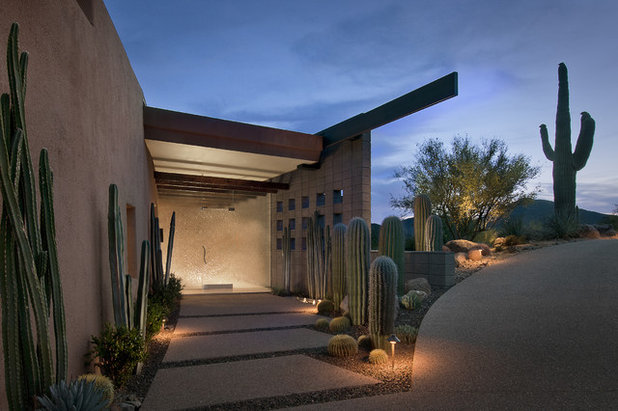
Tate Studio Architects
Columnar cacti, such as Mexican organ pipe and saguaro, were used to great effect in creating this dramatic entry.
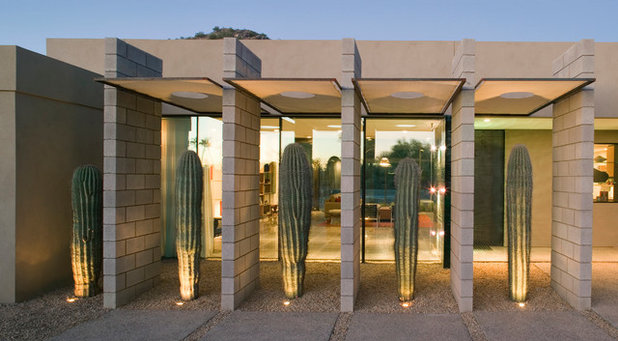
the construction zone, ltd.
1. Saguaro Cactus(
Carnegiea gigantea)
Native to the Sonoran Desert region of Arizona and northern Mexico
Perhaps the most iconic of cactus species, slow-growing saguaro adds unmistakable Southwestern style to outdoor spaces.
While the large multiarmed saguaro cactus has always been a popular choice in the landscape, saguaro “spears” are becoming more prevalent in newer landscape designs. These spears are young saguaro cactuses that have not grown arms yet. (Saguaro arms typically appear once the cactus reaches 50 years of age, although development can be hastened in landscape settings where water is more prevalent.) In addition to adding a modern twist to the landscape, they are also less expensive and easier to transport than ones with arms.
A group of three spears, each a different height, planted in a triangle, can provide a nice vertical accent for a landscape bed.
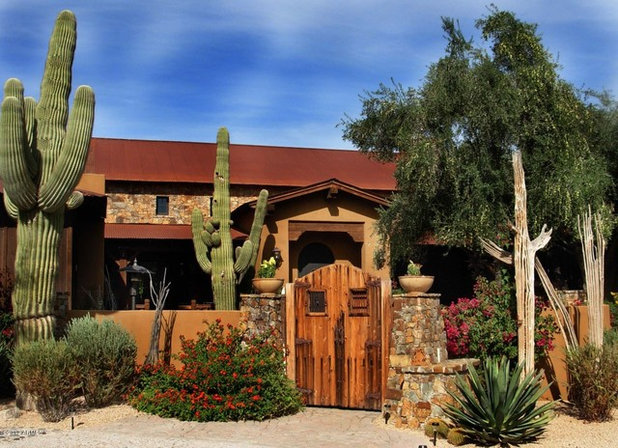
Younger Brothers Trusses and Panels
Two stately saguaros along with woody saguaro skeletons (called saugaro ribs) add vertical accents to the courtyard of this home.Where it will grow: Hardy to 18 degrees Fahrenheit, or minus 7.8 degrees Celsius (USDA Zone 8b; find your zone)
Water requirement: Very low
Light requirement: Full sun
Mature size: Multiarmed specimens: 25 to 40 feet tall; saguaro spears: 4 to 10 feet tall
Learn more about saguaro cactus
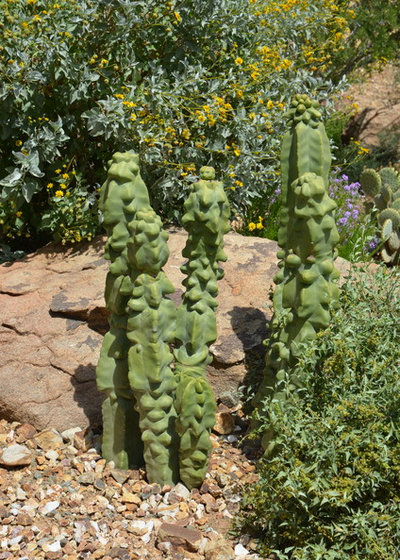
Noelle Johnson Landscape Consulting
2. Totem Pole Cactus(
Pachycereus schottii var.
monstrosus)
Native to Arizona and Baja California, Mexico
The bumpy, upright stems of totem pole cactus add a whimsical flair to the landscape and grab the attention of passersby. Besides its lumpy growth habit, this cactus is almost always thornless, eliminating the danger of being stabbed by thorns that exists with most other species of cactus. As they grow, they do branch out.
Totem pole cactus makes a great container plant and is perfect for hot, sunny corners. Its attractive gray-green color adds a visually cooling element.
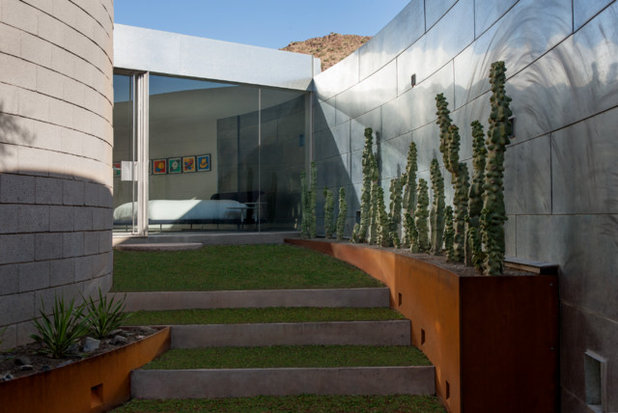
Stonecreek Building Company, Inc.
A row of totem pole cactuses in a raised bed accentuates the curved entry to this home.
Where it will grow: Hardy to 20 degrees Fahrenheit, or minus 6.7 degrees Celsius (Zone 9)
Water requirement: Low
Light requirement: Full sun
Mature size: 10 to 12 feet tall
See how to grow totem pole cactus
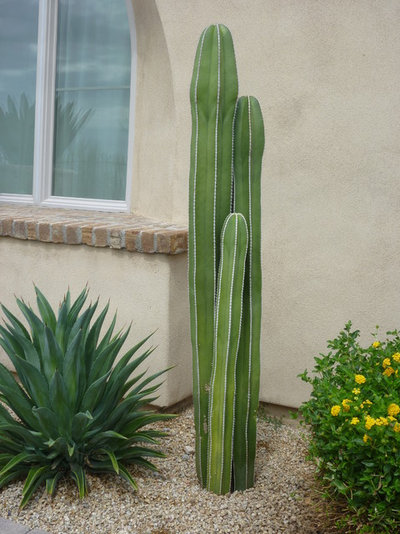
MTH Design Group
3. Mexican Organpipe Cactus(
Stenocereus marginatus)
Native to central Mexico
The dark green stems of Mexican organpipe cactus, also known as Mexican fence post, stand in stark contrast to the white margins that run up and down the length of the cactus. Short spines are confined to the white margins, leaving a smooth green surface in between. Unlike many cactus species, Mexican organpipe cactus has a moderate growth rate, producing additional stems that branch off from other stems.
This is one of the easiest columnar cactus species to propagate. Simply plant a section of the stem in well-drained soil.
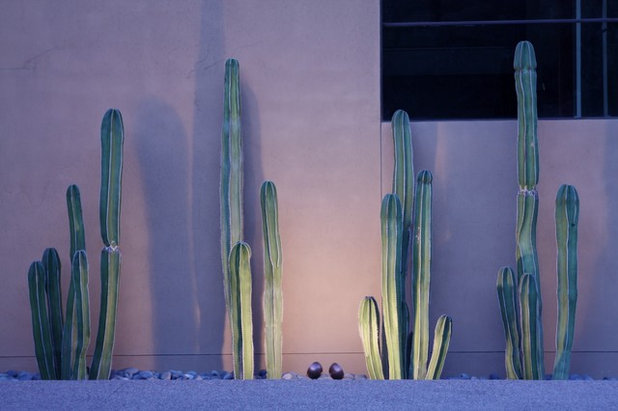
Rocket Garden Landscape Design
Shadows from uplit Mexican organpipe cactuses against this wall lead the eye upward.
Where it will grow: Hardy to 25 degrees Fahrenheit, or minus 3.9 degrees Celsius (Zone 9)
Water requirement: Low
Light requirement: Full sun
Mature size: 5 to 12 feet tall
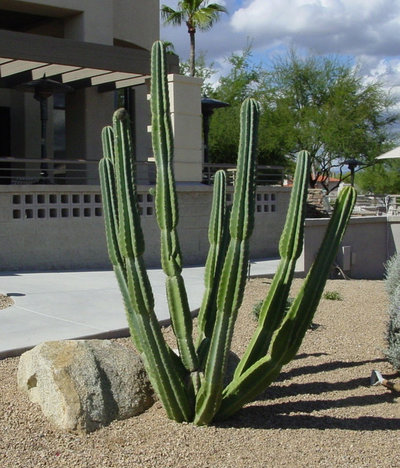
Noelle Johnson Landscape Consulting
4. Peruvian Apple Cactus(
Cereus repandus)
Native to South America; specific countries of origin are uncertain
This multitrunk cactus is a favorite among many due to its fast growth rate, availability at local nurseries and ease of propagating from cuttings or seed. The growth habit of Peruvian apple cactus can be maintained in an attractive vase shape.
The lightly fragrant white flowers that bloom at night in late spring are the most interesting feature of Peruvian apple, which is also called hedge cactus. An edible red fruit that resembles an apple follows the flowers.
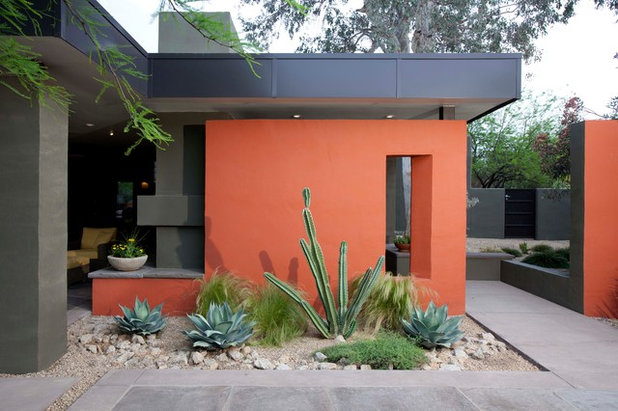
Exteriors By Chad Robert
A single Peruvian apple cactus anchors a planting bed surrounded by whale’s tongue agave (Agave ovatifolia) and Mexican feather grass (Stipa tenuissima).Where it will grow: Hardy to 20 degrees Fahrenheit, or minus 6.7 degrees Celsius (Zone 9)
Water requirement: Low
Light requirement: Full sun
Mature size: 15 to 20 feet tall
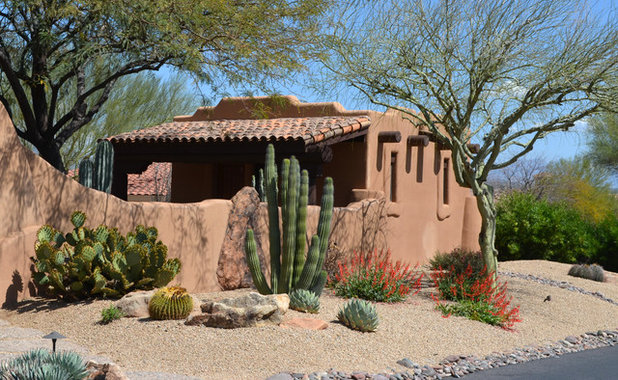
Noelle Johnson Landscape Consulting
A young organpipe cactus is framed by mesquite (Prosopis sp.) and palo verde (Parkinsonia sp.) trees in front of this Southwestern courtyard. Parry’s agave (Agave parryi), golden barrel cactus (Echinocactus grusonii), chenille pricklypear (Opuntia aciculata) and firecracker penstemon (Penstemon eatonii) create additional interest and color.5. Organpipe Cactus(
Stenocereus thurberi)
Native to southern Arizona and the western Sonoran Desert region of Mexico
Multiple stems gracefully arch upward from the base of this large cactus. Like saguaro cactuses, organpipe cactuses are long-lived, with specimens reaching 150 years in age. Bats are important pollinators for the creamy white flowers that open at night.
Because of their large size, organpipe cactuses are best used as single specimens in residential landscapes and given a prominent spot at the center of a bed.
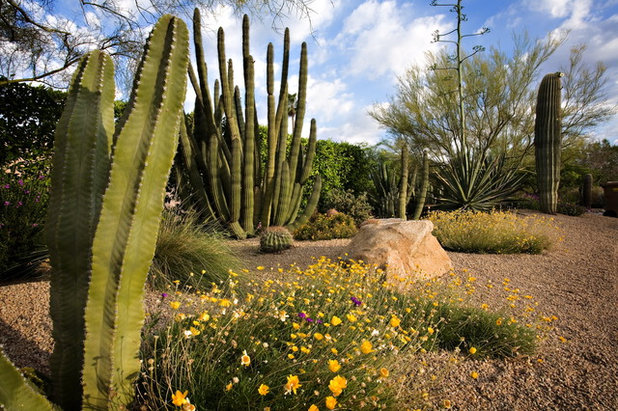
Exteriors By Chad Robert
The multiple arms of an organpipe cactus create this landscape’s focal point, with yellow-flowering angelita daisy (Tetraneuris acaulis) in the foreground.Where it will grow: Hardy to 20 degrees Fahrenheit, or minus 6.7 degrees Celsius (Zone 9)
Water requirement: Low
Light requirement: Full sun
Mature size: 20 to 25 feet tall





